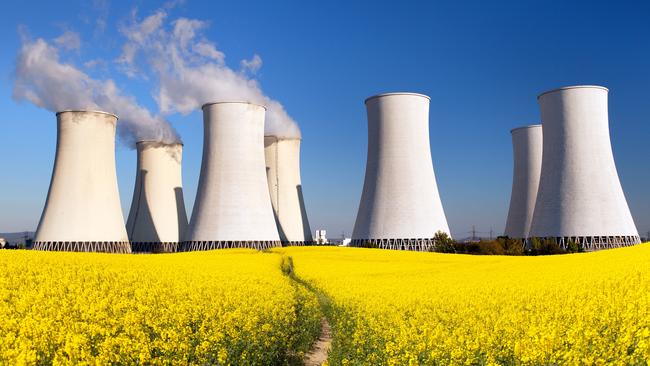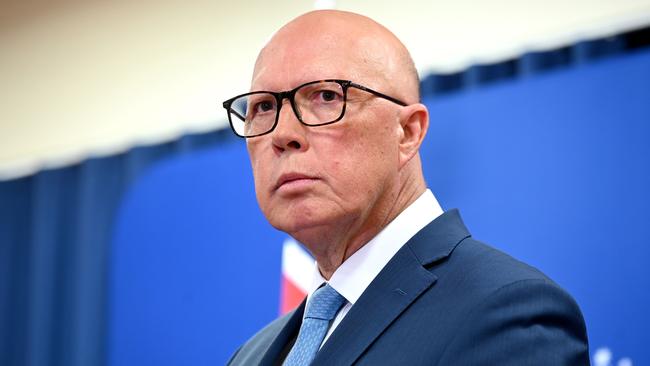Grattan Institute says history tells us to be wary of promises around nuclear costings
Pretty much every major energy project in Australia has run way over budget in recent years, so treat long-term nuclear costings with caution, the Grattan Institute’s Tony Wood says.

Business
Don't miss out on the headlines from Business. Followed categories will be added to My News.
There are “huge assumptions” in the economic modelling underpinning Peter Dutton’s nuclear energy plan, the Grattan Institute’s energy and climate change director Tony Wood says, adding that history tells us that cost blowouts in major projects such as these should be expected.
Mr Wood said the fundamental approach used in the modelling was “fine”, but warned that any plan to have a series of nuclear reactors up and running in the timeframe envisaged – with the first to be operational by 2035 or 2037 – had large obstacles to surmount.
“Do we really think we can build very large, 2000MW nuclear power stations in a country like Australia, with all the NIMBY stuff we’ve got, in the time scale available?’’ he said.
“Think about what it’s cost with everything else we’ve been building. Nothing has gone anywhere near the cost of what was estimated when we started, whether it’s transmission or generation or tunnels or road transport or Snowy Hydro.
“History tells us this is not going to happen this way.’’
Mr Wood said there were a number of large obstacles to overcome, not the least of which was the fact that the plan was currently illegal under Australian law, and changing the relevant legislation would require buy-in from federal and state governments.
Should Mr Dutton win the next election, getting a nuclear plan past the Greens and the Teals should they hold the balance of power, would likely be an impossibility, he said.
There were also large risks to the costings should the timeframe blow out – once again the rule rather than the exception in major Australian infrastructure projects in recent years.

“What if the nuclear is delayed and the coal-fired power stations must be kept open longer?’’ Mr Wood said.
“The risk that they will be delayed must be considered to be quite high and you’ve got to have a plan to deal with that.’’
Mr Wood said he wasn’t aware that the cost of keeping the coal-fired power stations open even under the anticipated timeframe had been factored in.
“I think that’s questionable as the coal-fired power stations need more and more maintenance as they’re getting older,’’ he said.
“We’ve seen that happening and I don’t think there’s any real question that that’s the case.
“Also if you keep them running longer you’re going to produce more emissions.’’
Mr Wood said he had spoken with the report’s author, Danny Price from Frontier Economics, and said he believed “the fundamental approach that has been used here is fine’’.
“The government’s never quite done it this way but that’s because they’ve never needed to, that is, ‘what’s the total system cost of doing it one way – without nuclear – and you want to get to zero emissions effectively, and what does it cost if you include nuclear?’
“Once you’ve done that you have some huge assumptions and some of the big ones are going to be things like – they have about 8 per cent of the capacity will be nuclear but it will be about 38 per cent of the energy, so you’re getting very high levels of occupancy from those plants and that’s challenging, but it’s not impossible.’’
Mr Wood said there was also a skills issue to be addressed.
He said once the plants were up and running, they were not dissimilar to coal-fired power plants in terms of the skill set needed.
“But the stuff that comes before that, the actual nuclear plant and all the things that go with it (are another matter).’’
Mr Wood said the promise of small modular nuclear reactors (SMRs) was that they were more of a plug and play model, supplied by a manufacturer.
However larger, 2000MW reactors, demanded a high level of sophistication to design, build and operate, and also on the ongoing regulatory front.
“And we’re going to be doing this, if you believe what’s going on in other parts of the world, at the same time everybody else is,’’ Mr Wood said.
“The good news is, that may help drive the cost down, but it may also mean you get some big bottlenecks.’’
Mr Wood said SMRs were all about replication and manufacturing, but “you’ve got to buy your place in the queue’’.
The Frontier Economics report is based on 13,000MW of nuclear being built out across NSW, Queensland and Victoria.
The Coalition policy envisages 14,000MW being built out across those states plus South Australia and Western Australia by 2050.
Mr Wood said in his experience the response of local communities to having a nuclear plant in their area was mixed, with people in areas such as the Latrobe Valley quite interested in the prospect of new jobs.
“There are other groups within that community which are not even slightly interested,’’ he said.
The nuclear plan would, as a positive for their social acceptance, result in fewer transmission lines being built, which were also a bone of contention in many communities.
“Many Australians have travelled overseas to countries where they have nuclear and don’t have trouble sleeping at night,’’ he said.
More Coverage
Originally published as Grattan Institute says history tells us to be wary of promises around nuclear costings




